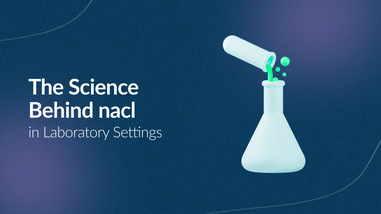- No products in the cart.
Nitric acid is a chemical compound that has a wide variety of commercial and industrial applications, from acting as a raw material in fertilizer production to being used as a laboratory reagent. Learn more about its features, uses, and safety measures when handling nitric acid.
Nitric acid Properties:
|
Properties |
|
|
Chemical formula |
HNO3 |
|
Molar mass |
63.012 g·mol−1 |
|
Appearance |
Colorless liquid[1] |
|
Odor |
Acrid, suffocating[1] |
|
Density |
1.51 g/cm3, 1.41 g/cm3 [68% w/w] |
|
Melting point |
−42 °C (−44 °F; 231 K) |
|
Boiling point |
83 °C (181 °F; 356 K) 68% solution boils at 121 °C (250 °F; 394 K) |
|
Solubility in water |
Miscible |
|
log P |
−0.13[2] |
|
Vapor pressure |
48 mmHg (20 °C)[1] |
|
Acidity (pKa) |
−1.4[3] |
|
Conjugate base |
Nitrate |
|
Magnetic susceptibility (χ) |
−1.99×10−5 cm3/mol |
|
Refractive index (nD) |
1.397 (16.5 °C) |
|
Dipole moment |
2.17 ± 0.02 D |
What is Nitric Acid and How Is It Produced?
Nitric acid is a colorless, odorless liquid composed of nitrogen and oxygen. It is highly corrosive and has been used for centuries in industrial applications, from being employed as an ingredient in explosives to its current use in the production of fertilizers and other chemicals. Nitric acid is typically produced through a reaction between ozone and nitrogen dioxide in the presence of water, although other methods are also available.
What Are The Main Uses Of Nitric Acid?
Nitric acid has a wide range of commercial and industrial applications. It is used as an oxidizing agent in the manufacture of dyes, pharmaceuticals, explosives, and metals. It can also be used in metal finishing to reduce surface oxidation and increase corrosion resistance. The acid is often employed as a precursor for generating nitrogen-based fertilizers for agricultural use. In addition, nitric acid can be used in wastewater treatment plants to regulate pH levels or to remove nitrogenous compounds from wastewater streams.
Some common uses of nitric acid include:
- Metal processing: Nitric acid is often used to clean and etch metal surfaces in the manufacturing of electronic components and in the preparation of metal surfaces for painting or plating.
- Chemical synthesis: Nitric acid is a key ingredient in the production of a wide range of chemicals, including fertilizers, explosives, and dyes.
- Laboratory use: Nitric acid is used in the laboratory as a reagent for the determination of various elements and compounds, and as a catalyst in chemical reactions.
- Water treatment: Nitric acid is sometimes used to adjust the pH of water in the treatment of drinking water and industrial waste water.
It is important to handle nitric acid with caution, as it is highly corrosive and can cause severe burns if it comes into contact with skin or mucous membranes.
What Possible Hazards Are Associated With The Use Of Nitric Acid?
Nitric acid 70% is a dangerous chemical and should be handled with caution. Inhalation of its vapors can cause irritation to the respiratory tract, while contact with skin or eyes may result in burns and heightened sensitivity to light. Prolonged exposure can severely damage tissue, leading to long-term health risks. The use of protective clothing and safety glasses when handling nitric acid is highly recommended. It is important to ensure that all areas where nitric acid is utilized are equipped with proper ventilation systems and spill containment measures as an additional precautionary measure.
Nitric acid is also a highly corrosive substance that can cause significant damage to metals, plastics, and many other materials. Therefore, when working with nitric acid it is important to wear protective clothing and gloves, as well as safety glasses to protect the eyes from any splashes of the chemical. Furthermore, spill containment should be utilized in areas where nitric acid is present to prevent potential contamination of the environment and water sources. Finally, it is important to store nitric acid in tightly sealed containers in a well-ventilated area away from sources of heat or flames.
How Can the Risk of using this Substance Be Minimized?
To minimize the risk associated with handling and using nitric acid, proper safety measures should be taken. Protective clothing, glasses, and a respirator are necessary to prevent injury or illness related to prolonged exposure. Employers should be trained in proper handling techniques, including best practices for safely storing and disposing of the acid. In addition, workplaces should be equipped with proper ventilation systems and any accidental spills should immediately be reported and cleaned up.
Where Can You Purchase Nitric Acid For Lab and Industrial Use?
Nitric acid can be obtained from most chemical supply stores either in-person or online such as Lab Pro Inc. As with all hazardous materials, precaution must be taken when handling and storing nitric acid. When buying from a licensed professional, make sure to ask about the safety measures that need to be taken when using this substance. Always read and understand the Material Safety Data Sheet before picking up any chemicals, as it contains information on its safe use, storage, transportation, and disposal.
About Lab Pro
For over 40 years, Lab Pro Inc. has been committed to delivering the highest quality critical cleaners, hand tools, chemicals, lab equipment, distance learning kits, lab supplies, and cleanroom PPE apparel to medical device companies and laboratories worldwide. To learn more, visit the biggest Lab Supply showroom in California, or contact us online or at 888-452-2776.












































